The 2018 Apple iPad Pro (11-Inch) Review: Doubling Down On Performance
by Brett Howse & Andrei Frumusanu on December 4, 2018 10:00 AM ESTGPU Performance
Apple’s custom GPU in the iPad Pro is the same one found in the iPhone, but with more cores available. And with the larger surface area of the iPad compared to the phone, likely a higher frequency as well. There’s now seven of the A12 GPU cores, compared to just four on the iPhone, and Apple claims the GPU in the iPad Pro is equivalent to an Xbox One S, although how they came to thise conclusion is difficult to say since we know so little about the underpinnings of the GPU.
In rough terms, the Xbox One S is roughly 1.4 TFLOPS at its peak. But for better or worse, when the PC moved to unified shaders, the industry moved to FP32 for all GPU functions. This is as oppposed to the mobile world, where power is an absolute factor for everything, Vertex shaders are typically 32bpc while Pixel and Compute shaders can often be 16bpc. We’ve seen some movement on the PC side to use half-precision GPUs for compute, but for gaming, that’s not currently the case.
Overall, that makes like-for-like PC comparisons difficult. An AMD Ryzen 2700U SoC has a Vega GPU which offers 1.66 TFLOPS of FP32 performance, in theory. If run at 16-bit, that number would double, in theory. The iPad Pro would likely use half-precision for some of the GPU workload. This has been an issue for years and has made it difficult easily compare any cross-platform benchmark against the PC.
As with the iPhone, Apple’s peak GPU performance, even in the iPad, is still significantly higher than sustained performance. Please check out our iPhone XS review for Andrei’s deeper dive into this, but thanks to GPU compute transactional workloads in iOS, having high peak performance is a benefit even if it can’t be sustained over time.
3DMark Sling Shot 3.1 Extreme Unlimited


Here is our first look at the GPU in the iPad Pro compared to the mobile competition. Despite having only 75% more GPU cores than the iPhone XS Max, the iPad Pro scores 164% higher in the graphics result, which will be down to the clockspeed of the GPU and increased memory bandwidth. It is well ahead of everything else in the mobile world.
In the Physics result, which is more of a CPU test, the iPad Pro is still the highest result, but gap to the competition is much lower.
Also of note is that this benchmark is extremely unreliable on the iPad, crashing most of the times it is run.
3DMark Ice Storm Unlimited
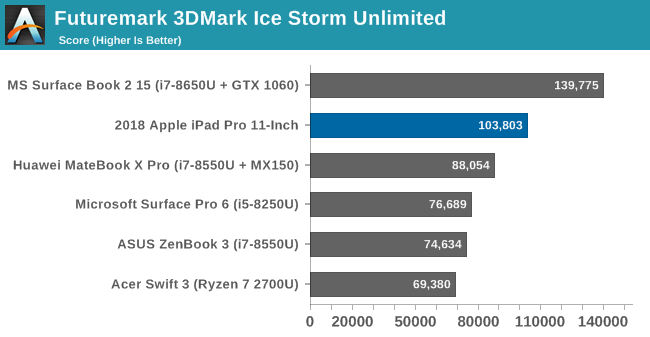
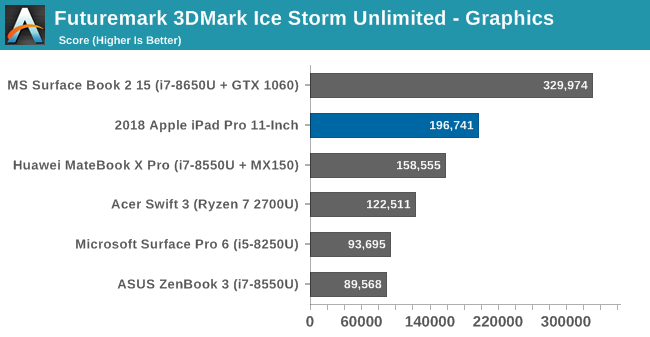
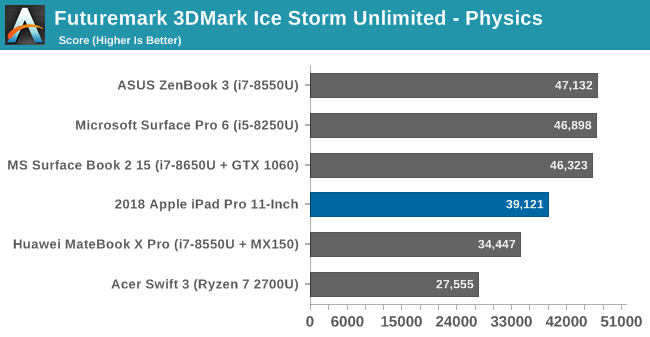
Here is the first test we can use to compare against the PC, but unlike Sling Shot which uses Metal on iOS, this test relies on OpenGL ES 2.0. On Windows, it uses DX11, and of course the precision is not the same across mobile and PC with the PC version running at 32-bit and OpenGL ES 2.0 only using 16-bit.
Overall, the iPad Pro is well ahead of any of the PCs in this test, although the Physics test does show that the latest Intel CPUs still hold an edge over the iPad in this test. On the graphics side though, the iPad Pro scores over double the AMD Ryzen 7 2700U with Vega, and unsurprisingly Intel’s UHD 620 GPU brings up the rear.
GFXBench
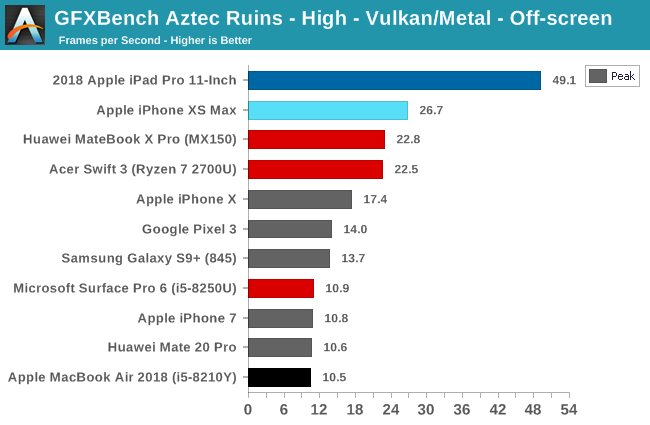
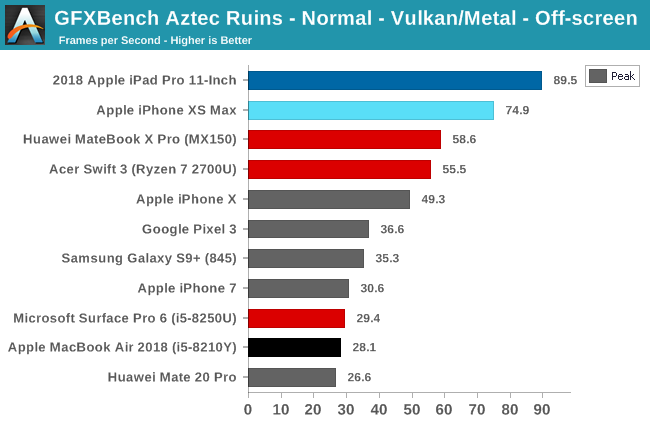
The latest test from GFXBench is Aztec Ruins which offers both a normal mode in 1920x1080 resolution, as well as a high mode which is run at 2560x1440. It is quite a bit more complex than their older tests, and Kishonti has created the test in all of the modern API: Vulkan, Metal, and OpenGL ES 3.2 for mobile, and on the desktop it is available in OpenGL, DX11, and DX12. For our purposes, we’ll disregard OpenGL on the desktop since it is well on its way out at this point.
Peak performance of the iPad Pro is far above any of the 15-Watt laptops we tested. We’re unsure right now if the Metal version uses half-precision shaders, but Kishonti's old benchmarks did, so it likely is here as well. The gap compared to the iPhone isn’t huge though at the Normal settings, indicating that the benchmark is getting CPU bottlenecked at low resolutions. The High settings show an 80% increase in performance with the iPad compared to the iPhone XS.
Sustained Results
As hinted to above, Apple offers significantly more peak performance from the GPU than sustained, which can be beneficial for computational GPU in the OS for various functions. But for gaming, sustained performance is important.
GFXBench offers a battery rundown mode where Manhattan 3.1 is looped consecutively. For a comparative basis, if you run Manhattan 3.1 on the iPad the result is 100.79 frames per second on a single run, which is 6249 frames.
The longer test starts out high, but then decreases in performance significantly in the first couple of runs, and then starts to taper off near the end. The lowest framerate in this roughly 30-minute test is 3960.9 frames, which works out to 63.9 frames per second. That’s about a 36% decrease in performance over time.
Gaming results
All of these synthetics have a place but actual gaming is what people want extra performance for. When Apple states that the iPad Pro has an Xbox One S class GPU, that means in games, because you don’t use an Xbox One S to do transactional compute workloads.
All of the above caveats apply though, and it’s compounded by there being almost no cross-platform games available on both the PC and iPad. One exception to this rule is Civilization VI, which now offers pretty much a full port of the PC version on iPad.
On the iPad, Civilization VI is configured to use Metal, compared to either DX11 or DX12 on the PC. As an iPad app though, there are far fewer configuration options in iOS, but with the right tools you can access the configuration text file and make a few changes.
By default, the game on iOS runs at just a 1112x834 resolution – the non-retina resolution of the last-generation 10.5-inch iPad Pro – and there’s no way to customize the graphics through the UI like there is in the PC version of the game. You can edit the config file to unlock the Retina version of that resolution though, which doubles the effective resolution to 2224x1668. Also, because the game is a port of the PC version, you can also access the debug menu to get a look at the frame times.
We loaded up the same save game file on all devices, and the same configuration file on multiple devices, with the game resolution within 1% of the iPad, and then checked out the frame times for each:
At stock settings on the iPad, the GPU had no issues capping out the frame rate at the 27 Frames per second maximum.
Doubling the resolution of Civilization VI had literally no impact on performance. The iPad Pro can run at 2224x1668 easily framerate limited to the same 27 FPS of the non-Retina version of the game.
Intel’s UHD 620 paired with the Core i5 in the Surface Pro 6 is not framerate limited, but it is GPU bound, at just over 21 FPS.
The GeForce MX150 in the Huawei MateBook X Pro is the lower TDP version of the MX150, capping at around 1038 MHz. It’s able to achieve 45 FPS consistently.

Our last device features the AMD Ryzen 7 2700U, which has 10 Vega Compute Units in a 15-Watt TDP. It offers the highest performance at these settings, with almost 50 FPS average.
The results from Civilization VI is more or less the entire iPad Pro experience in a nutshell. The A12X SoC has ample performance, but the limitations of the implementation of this game on iOS limits what the user can achieve. With a frame lock of roughly 27 frames per second, the iPad Pro has no issues at all maxing that out at all times, and the benefit of a frame rate limiter is that the amount of power required is much lower, and therefore the battery life is better. But unlike the PC there is really no way to get around this limitation. Civilization VI isn’t the kind of game that needs really high framerates to be playable, but it is rarely up to the user as to what they can do on iOS. The game was clearly ported to ensure consistent performance on the earlier models of iPad, and when Apple drops a much faster GPU in the iPad, there’s no way to adjust the performance to take advantage of it.
GPU Conclusion
So is the iPad Pro an Xbox One S class of GPU? Likely it is. The Xbox One S is only slightly quicker than the original Xbox One launched in 2013, and that console would struggle to achieve 1080p in games of that vintage. The Vega iGPU in the Ryzen 7 2700U offers more theoretical FLOPS than the Xbox One S, although at a higher TDP of 15-Watts, compared to the iPad Pro. In the synthetic tests, the iPad Pro scored higher than the Vega GPU, albeit at a lower precision, but regardless, there’s little doubt that the GPU in the iPad Pro is quite powerful. Add in the efficiency and the lower TDP, and results are even stronger. On the sustained performance run, the iPad was averaging just under 8 Watts of draw for the entire device.















145 Comments
View All Comments
thunng8 - Wednesday, December 5, 2018 - link
Yes, way ahead of Core M, especially for graphics. Something like 5-6X faster in gfxbench.Brett Howse - Wednesday, December 5, 2018 - link
There's a few results in there already from the MacBook Air with Y Series.name99 - Wednesday, December 5, 2018 - link
The most interesting thing, to me, is the cache topology.While everyone else at the high end has been retreating to private L2 caches, and a large shared L3, Apple has doubled down on a
- LARGE L2 that's
- shared by at least 4 clients
with L3 acting more as the communications/sharing space between different blocks like CPU, GPU, ISP, NPU.
Clearly it's working for them! It also suggests that when they scale even larger (the inevitable ARM Macs and [internal use] servers) they'll likely ship something that looks very different from not just Intel's high end (private L2, distributed L3 slice per core) but perhaps also the current ARM servers?
Do we know anything at all about the NoC that's in use on Apple SoCs, and, second best, on other ARM SoCs (eg QC, Samsung)? A ring? A crossbar? Point to point with direct links from each block to L3, but no block-to-block communication?
Railgun - Wednesday, December 5, 2018 - link
These reviews lately are killing me. Zero consistency from chart to chart. Why in one metric are we comparing a tablet to phones, and others to other tablets...and nada against its predecessor? There are so many reviews like this.Brett Howse - Wednesday, December 5, 2018 - link
Some of the tests are mobile only.Some of the tests are not.
This device bridges both so why would we not compare it to both?
Socius - Wednesday, December 5, 2018 - link
Charging time with a proper adapter is insanely fast on the iPad pro. Using a 20,000mah battery pack, I was able to charge it up from 3% to 45% in about 30-35 minutes. That is absolutely incredible.Also, you can change the tip on the Apple Pencil as it is a simple screw off design. Apple itself doesn't sell different tips but I'm sure 3rd party would step in pretty soon.
One thing you didn't cover is the disk read/write performance. And it differs greatly based on which model iPad you get. The 12.9" 1TB WiFi model is substantially faster than other capacities. And the extra ram has helped keep apps/games in memory far longer than they would on my XS Max with its 4GB ram.
We'll be able to better compare the productivity performance of the iPad Pro once the full Photoshop CC port is released in 2019. But in the mean time, I'm editing through 4K videos using LumaFusion like it's nothing. This isn't a desktop. But with the right apps, it can come pretty close to being able to handle 90% of your workflow. In such a small and portable package. I find myself designing websites on it while sitting on the couch. The drag-and-drop feature between application windows in split view is such a big help as well.
Overall, I picked the iPad Pro over the Surface Pro due to the 120Hz display. And once Photoshop is ported over in a few months, I'll be able to do so much more of my work on it. I think my only gripe is that Microsoft Office is so weak on the iPad Pro. If only I had access to the full desktop version.
lilo777 - Wednesday, December 5, 2018 - link
1. Don't work on your couch.2. iPad does not have 120Hz display
darklight69 - Thursday, December 6, 2018 - link
1. He/She can work wherever they feel like. What kind of control freak are you to demand otherwise from complete strangers.2. Yes it does, says so in the review's display section - https://www.anandtech.com/show/13661/the-2018-appl...
"In addition, Apple’s iPad Pro offers their ProMotion technology, which means it is a 120 Hz display, but one that supports variable refresh rates in order to lower the display's refresh rate for power management purposes."
WasHopingForAnHonestReview - Wednesday, December 5, 2018 - link
Nonsense. How much are you paid for this co?mmentSocius - Thursday, December 6, 2018 - link
Which part of what I said do you disagree with or find questionable?